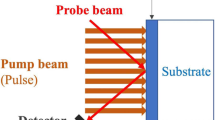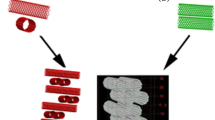Abstract
We presented a relationship between the temperature control and measurement stability limit and the temperature resolution, particularly for using rhodium-iron resistance thermometers and AC resistance bridges. Based on this, temperature control was investigated and demonstrated in primary gas thermometry under various working conditions. With optimized parameters, micro-Kelvin level temperature control stability was realized in the temperature region from 5 K to 24.5 K. The temperature control stabilities are better than 8 µK over 180 h with an integration time of 33.6 s in the concerned temperature range, closing to the limit that the sensors and the instruments can control and measure. These stabilities were significantly improved about (44 ± 8)% at 24.5 K and (70 ± 7)% at 5 K comparing with our previous work (Chen et al., Cryogenics, 2019, 97: 1–6).
Similar content being viewed by others
Abbreviations
- AC:
-
Alternating current
- GM-PTC:
-
GM type pulse tube cooler
- ITS-90:
-
International Temperature Scale of 1990
- NPL:
-
National Physical Laboratory
- PID:
-
Proportion-Integration-Differentiation
- RTRT:
-
Rhodium-iron resistance thermometer
- SI:
-
International System of Units
- SPRIGT:
-
Single-pressure refractive-index gas thermometry
- c :
-
Voltage noise coefficient/nVHz−1/2·Ω−1
- I :
-
Excitation current/mA
- I c :
-
Excitation current of the controlled NPL2 sensor/mA
- I m :
-
Excitation current of the measuring NPL1 sensor/mA
- N :
-
Total measured data point number
- n :
-
Transformer ratio, i.e. Rt/Rs, or measuring index
- p :
-
4He gas pressure in the resonator/kPa
- R 1 :
-
Potential lead resistance of standard resistor/Ω
- R 2 :
-
Potential lead resistance of temperature sensor/Ω
- R 2 :
-
Goodness of Fit
- R e :
-
Extra resistance/Ω
- R cl :
-
Total current lead resistance/Ω
- R out :
-
Bridge output impedance/Ω
- R pl :
-
Total potential lead resistance/Ω
- R s :
-
Resistance of standard resistor/Ω
- R t :
-
Resistance of temperature sensor/Ω
- S :
-
Sensitivity/Ω·K−1
- t :
-
Measuring time/h
- T :
-
T90 Temperature/K
- T − :
-
Temperature/K, smaller than the average one (T>Tavg)
- T + :
-
Temperature/K, larger than the average one (T>Tavg)
- T avg :
-
Average temperature/K
- T set point :
-
Temperature of the set point/K
- ΔT :
-
Temperature difference/K
- u(σ T) :
-
Standard uncertainty of the measured temperature stability/µK
- u(σ T,L) :
-
Standard uncertainty of the temperature stability limit/µK
- V A :
-
Analogue output voltage of the F18 bridge/V
- x :
-
The x-th measured data point
- α :
-
Temperature coefficient of the thermometer/K−1
- β :
-
Ratio of the second derivative to the first derivative of resistance with respect to temperature/K−1
- δ R :
-
Resistance resolution/µΩ
- δ T :
-
Resolution of the temperature sensor/µK
- δ v :
-
Specific voltage resolution of the AC
- δ v :
-
bridges/nV·Ω−1
- δ V :
-
Voltage resolution of the AC bridges/nV
- σ T :
-
Measured temperature stability/µK
- σ T,L :
-
Temperature stability limit/µK
- σ R,T,L :
-
Relative temperature stability limit
- τ :
-
Integration time/s
- τ g :
-
Generated integration time/s
- A:
-
Analogue output
- avg:
-
Average value
- c:
-
Controlled
- L:
-
Limit value
- m:
-
Measuring
- R:
-
Relative values or resistance
References
Phillips W.D., The end of artefacts. Nature Physics, 2019, 15: 518.
Gibney E., New definitions of scientific units are on the horizon. Nature, 2017, 550: 312–313.
Klitzing K.V., Metrology in 2019. Nature Physics, 2017, 13: 198.
Mise en pratique for the definition of the kelvin in the SI. https://www.bipm.org/utils/en/pdf/si-mep/SI-App2-kelvin.pdf, 2019 (accessed on May 20, 2019).
Rourke P.M., Gaiser C., Gao B., Ripa D.M., Moldover M.R., Pitre L., Underwood R.J., Refractive-index gas thermometry. Metrologia, 2019, 56: 032001.
Gao B., Zhang H.Y., Han D.X., Pan C.Z., Chen H., Song Y.N., Hu J.F., Kong X.J., Sparasci F., Plimmer M., Luo E.C., Pitre L., Measurement of thermodynamic temperature between 5 K and 24.5 K with single-pressure refractive-index gas thermometry. Metrologia, 2020, 57: 065006.
Gao B., Pitre L., Luo E.C., Plimmer M.D., Lin P., Zhang J.T., Feng X.J., Chen Y.Y., Sparasci F., Feasibility of primary thermometry using refractive index measurements at a single pressure. Measurement, 2017, 103: 258–262.
Pitre L., Sparasci F., Truong D., Guillou A., Risegari L., Himbert M.E., Determination of the Boltzmann constant using a quasi-spherical acoustic resonator. Philosophical Transactions of the Royal Society A: Mathematical, Physical and Engineering Sciences, 2011, 369: 4014–4027.
Gaiser C., Fellmuth B., Haft N., Primary dielectric-constant gas thermometry in the range from 2.4 K to 26 K at PTB. International Journal of Thermophysics, 2008, 29: 18–30.
Pitre L., Sparasci F., Risegari L., Guianvarc’h C., Martin C., Himbert M., Plimmer M., Allard A., Marty B., Albo P.G., New measurement of the Boltzmann constant k by acoustic thermometry of helium-4 gas. Metrologia, 2017, 54: 856–873.
Rourke P.M.C., NRC microwave refractive index gas thermometry implementation between 24.5 K and 84 K. International Journal of Thermophysics, 2017, 38: 107.
Gavioso R.M., Madonna Ripa D., Steur P.P.M., Dematteis R., Imbraguglio D., Determination of the thermodynamic temperature between 236 K and 430 K from speed of sound measurements in helium. Metrologia, 2019, 56: 045006.
Osadchii S.M., Potapov B.G., Petukhov A.A., Sokolov N. A., Dragunov O.E., Pilipenko K.D., Stabilization of the temperature of resonator of an acoustic gas thermometer. Measurement Techniques, 2018, 61: 932–936.
Berry K.H., NPL-75: A low temperature gas thermometry scale from 2.6 K to 27.1 K. Metrologia, 1979, 15(2): 89–115.
Gaiser C., Fellmuth B., Haft N., Primary dielectric-constant gas thermometry in the range from 2.4 K to 26 K at PTB. International Journal of Thermophysics, 2008, 29: 18–30.
Zhang H.Y., Gao B., Liu W.J., Pan C.Z., Han D.X., Plimmer M.D., Luo E.C., Pitre L., Resonance frequency measurement with accuracy and stability at the 10–12 level in a copper microwave cavity below 26 K by experimental optimization. 2020, 31: 075011.
Gao B., Chen H., Han D.X., Gambette P., Zhang H.Y., Pan C.Z., Liu Y.W., Yu B., Luo E.C., Plimmer M.D., Pitre L., Realization of ppm level pressure stability for primary thermometry using a primary piston gauge. Measurement, 2020, 160: 107807.
Rusby R., Head D., Meyer C., Tew W., Astrov D., Key Comparison: Final report on CCT-K1: Realizations of the ITS90, 0.65 K to 24.5561 K, using rhodium iron resistance thermometers. Metrologia, 2006, 43: 03002.
Gaiser C., Fellmuth B., Steur P., Szmyrka-Grzebyk A., Manuszkiewicz H., Lipinski L., Peruzzi A., Rusby R., Head D., EURAMET key comparison no. EURAMET. T-K1: realisations of the ITS-90 from 2.6 K to 24.5561 K, using rhodium-iron resistance thermometers. Metrologia, 2017, 54: 03002.
Nakano T., Tamura O., Sakurai H., Comparison system for the calibration of Capsule-type standard Platinum resistance thermometers at NMIJ/AIST. International Journal of Thermophysics, 2008, 29: 881–889.
Preston-Thomas H., The international temperature scale of 1990. Journal of Chemical Thermodynamics, 1990, 27: 3–10.
Gao B., Pan C.Z., Chen Y.Y., Song Y.N., Zhang H.Y., Han D.X., Liu W.J., Chen H., Luo E.C., Pitre L., Realization of an ultra-high precision temperature control in a cryogen-free cryostat. Review of Scientific Instruments, 2018, 89: 104901.
Chen Y.Y., Zhang H.Y., Song Y.N., Pan C.Z., Gao B., Liu W., Chen H., Han D., Luo E.C., Plimmer M.D., Pitre L., Thermal response characteristics of a SPRIGT primary thermometry system. Cryogenics, 2019, 97: 1–6.
Pan C.Z., Gao B., Song Y.N., Zhang H.Y., Han D.X., Hu J.F., Liu W.J., Chen H., Plimmer M., Sparasci F., Luo E.C., Pitre L., Active suppression of temperature oscillation from a pulse-tube cryocooler in a cryogen-free cryostat: Part 1. Simulation modeling from thermal response characteristics. Cryogenics, 2020, 209: 103097.
Pan C.Z., Hu J.F., Zhang H.Y., Song Y.N., Han D.X., Liu W.J., Chen H., Plimmer M., Sparasci F., Luo E.C., Gao B., Pitre L., Active suppression of temperature oscillation from a pulse-tube cryocooler in a cryogen-free cryostat: Part 2. Experimental realization. Cryogenics, 2020, 109: 103096.
F18 Operator’s Handbook. http://www.isotechna.conW/vspfiles/product_manuals/asl/F18.pdf, (accessed on May 10, 2019).
Angel E., Problem-solving strategies (Problem books in Mathematics), Springer-Verlag, New York, 1998, pp. 163.
F900 Operator’s Handbook. http://www.isotechna.com/v/vspfiles/product_manuals/asl/F900.pdf, (accessed on June 29, 2019).
Allan D.W., Statistics of atomic frequency standards, Proceedings of the IEEE, 1966, 54: 221–230.
Acknowledgment
This work was supported by the National Key Research and Development Program of China (Grant No. 2016YFE0204200), the National Natural Science Foundation of China (Grant No. 51627809 and 52006231), the International Partnership Program of the Chinese Academy of Sciences (Grant No. 1A1111KYSB20160017), the Scientific Instrument Developing Project of the Chinese Academy of Sciences (Grant No. ZDKYYQ20210001), the European Metrology Research Program (EMRP) Joint Research Project 18SIB02 “Real K”, the CAS Key Laboratory of Cryogenics, Technical Institute of Physics and Chemistry (Grant No. CRYOQN202110). This work was also supported by the project “15SIB02 InK 2” which has received funding from the EMPIR programme co-financed by the Participating States and from the European Union’s Horizon 2020 research and innovation programme. Changzhao Pan is grateful for the funding provided by a Horizon 2020 Marie Skłodowska Curie Individual Fellowship 2018 (No. 834024).
The authors are deeply grateful to our colleague Ying Ma for expert technical assistance. We gratefully acknowledge Richard Rusby from NPL for calibrating three rhodium-iron resistance thermometers, sharing his long experience and giving constant advice on temperature measurements.
Author information
Authors and Affiliations
Corresponding authors
Rights and permissions
About this article
Cite this article
Hu, J., Zhang, H., Song, Y. et al. Investigation of High-Stability Temperature Control in Primary Gas Thermometry. J. Therm. Sci. 31, 765–776 (2022). https://doi.org/10.1007/s11630-022-1533-9
Received:
Published:
Issue Date:
DOI: https://doi.org/10.1007/s11630-022-1533-9




